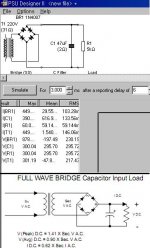According to a Hammond document, Full Wave Bridge Capacitor Input Load has
V(Peak) D.C.= 1.41 X Sec. V A.C.
V(Avg) D.C.= 0.90 X Sec. V A.C.
I D.C.= 0.62 X Sec. I A.C.
So, I simulate this principle with Duncan's.
(See the picture attached.) Input Sec A.C. is 220V.
Well, the V D.C. in PSU seems a lot higher than it. Actual measurement from my 6V6 SE, which has 220V Sec. A.C.,
also shows the same result as Duncan's.
Can you tell me what I did miss?
Thanks.
@The Hammond tech. document mentioned is from http://hammondmfg.com/pdf/5c007.pdf
V(Peak) D.C.= 1.41 X Sec. V A.C.
V(Avg) D.C.= 0.90 X Sec. V A.C.
I D.C.= 0.62 X Sec. I A.C.
So, I simulate this principle with Duncan's.
(See the picture attached.) Input Sec A.C. is 220V.
Well, the V D.C. in PSU seems a lot higher than it. Actual measurement from my 6V6 SE, which has 220V Sec. A.C.,
also shows the same result as Duncan's.
Can you tell me what I did miss?
Thanks.
@The Hammond tech. document mentioned is from http://hammondmfg.com/pdf/5c007.pdf
Attachments
Not sure where you see the discrepancy. Hammond's paper will claim 220 * 1.41 = 310 V dc. PSUD gives results of 296V, which agrees with your measured results.
The Hammond doc is a ballpark estimator used to allow you to pick the secondary voltage you need for a given load and PS topology. It is not meant to predict accurately. Their equation does not take into account the regulation properties of the transformer, diode (tube or SS) drop, or load current. As a result, their equation will provide the maximum voltage you could expect.
PSUD takes all these variables into account, and IME produces honorable results within two or three volts of actual measured results. Discrepancies are more often than not poor modeling on my part of the tranny and rectifiers.
Summary: use 1.41 as a ballpark to pick the tranny you need, and verify proper operation with PSUD for the best estimate.
The Hammond doc is a ballpark estimator used to allow you to pick the secondary voltage you need for a given load and PS topology. It is not meant to predict accurately. Their equation does not take into account the regulation properties of the transformer, diode (tube or SS) drop, or load current. As a result, their equation will provide the maximum voltage you could expect.
PSUD takes all these variables into account, and IME produces honorable results within two or three volts of actual measured results. Discrepancies are more often than not poor modeling on my part of the tranny and rectifiers.
Summary: use 1.41 as a ballpark to pick the tranny you need, and verify proper operation with PSUD for the best estimate.
zigzagflux said:Not sure where you see the discrepancy. Hammond's paper will claim 220 * 1.41 = 310 V dc. PSUD gives results of 296V, which agrees with your measured results.
The Hammond doc is a ballpark estimator used to allow you to pick the secondary voltage you need for a given load and PS topology. It is not meant to predict accurately. Their equation does not take into account the regulation properties of the transformer, diode (tube or SS) drop, or load current. As a result, their equation will provide the maximum voltage you could expect.
PSUD takes all these variables into account, and IME produces honorable results within two or three volts of actual measured results. Discrepancies are more often than not poor modeling on my part of the tranny and rectifiers.
Summary: use 1.41 as a ballpark to pick the tranny you need, and verify proper operation with PSUD for the best estimate.
Thanks. I am a novice for electronics. Let me clarify this thing if I am wrong.
1. Well, does 'peak' mean 'max' in V A.C. ? You know that V A.C. varies from min to max.
2. Where can I find V D.C (avg) value either in real measurement or PSU simul.?
I think the Hammond info for capacitor input is wrong. I don't know where they got their V(Avg)DC figure from, unless they accidentally copied it from the choke input info.
BTW, the line that says I D.C. = 0.62 X Sec. I A.C. is correct. It's a warning, effectively, that with cap input your DC current is limited to 60% of the rated secondary AC current.
BTW, the line that says I D.C. = 0.62 X Sec. I A.C. is correct. It's a warning, effectively, that with cap input your DC current is limited to 60% of the rated secondary AC current.
- Status
- This old topic is closed. If you want to reopen this topic, contact a moderator using the "Report Post" button.
